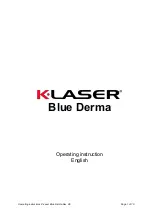
RTC
®
5 PC Interface Board
Rev. 1.9 e
7 Basic Functions for Scan Head and Laser Control
94
innovators for industry
Mark Commands
The RTC
®
5 automatically turns on the “laser active”
laser control signals at the beginning of a mark
command. During a mark command (
or
(1)
), the laser focus moves along the spec-
ified vector with a constant
marking speed
,
producing a straight mark on the workpiece.
If another mark (or arc) command follows immedi-
ately afterward, the RTC
®
5 leaves the “laser active”
laser control signals on. Therefore, a sequence of
individual mark (and arc) commands creates a
continuous marking (polyline mark). Turn-off of the
“laser active” laser control signals occurs at the
beginning of the jump (or generally: non-mark/non-
arc) command that follows the final mark (or arc)
command of a polygonal traversal (also see
).
The commands
marking speed. The marking speed can be changed
anywhere in a list or via the corresponding control
command if no list is currently being processed.
Arc Commands
The arc commands
and
for marking circular arcs
(2)
. These commands require
parameters for the X and Y coordinates of the arc
center and the arc angle. The circular arc starts at the
current output position, with angles counted posi-
tively and clockwise (in contrast to mathematical
convention).
At the beginning of an arc command, the RTC
®
5 also
automatically turns on the “laser active” laser control
signals. During an arc command, the laser focus
moves with the defined marking speed along the
specified arc. The “laser active” laser control signals
are turned off at the beginning of the subsequent
jump (or generally: non-mark, non-arc or non-ellipse)
command, provided no further arc commands (or a
series of arc, mark or ellipse commands) follow.
Ellipse Commands
The RTC
®
5 software driver also provides commands
for marking elliptical arcs. Here (unlike marking of
vectors or circular arcs), you’ll generally need two
commands per arc:
and the arc command
(3)
.
The
command is used for specifying the
arc’s shape in the following manner (see
):
• Lengths
a
and
b
of the ellipse’s half-axes
• The beginning phase angle
Phi0
(and thereby the
arc starting point’s position relative to the end
point of half-axis
a
)
• The arc angle
Phi
(and thereby the length of the
to-be-marked ellipse section)
The arc commands
or
specify the to-be-executed arc’s
position and orientation in the following manner
(siehe
• The coordinates
(X,Y)
of the ellipse’s midpoint
• The angle
Alpha
between the ellipse’s half-axis
a
and the X axis.
Notes
• Via
a
, you can specify either the short or long half-
axis (then use
b
for the other axis).
Phi0
,
Phi
and
Alpha
are always relative to axis
a
.
•
Phi0
and
Phi
are counted positively clockwise (in
contrast to mathematical convention). In
contrast,
Alpha
is counterclockwise (in accor-
dance with mathematical convention).
(1) For using abs and rel commands see “AbsCalls”
.
Additionally, the RTC
®
5 provides timed vector commands (see
), para vector commands (see
) and – if the
3D option is enabled – 3D vector commands (see
(2) For using abs and rel commands see “AbsCalls”
.
Additionally, the RTC
®
5 provides timed arc commands (see
(3) For using abs and rel commands see “AbsCalls”
(X,Y)
a
b
x
y
1
2
3
Phi0
Phi
Alpha
28
Marking ellipse-shaped arcs
Legend
1
Starting point
2
Marked arc
3
End point
















































